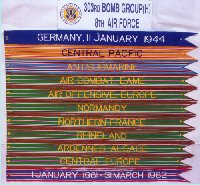 |
Credited Campaigns |
Personnel
Mission Reports





ASIATIC-PACIFIC THEATER: 7 December 1941 to March 1946 (427th)
- Central Pacific: 7 December 1941 to 6 December 1943 The war in the Central Pacific began with the Japanese attack on Pearl Harbor on 7 December 1941. Six months later an AAF task force took part in the Battle of Midway in which a great Japanese fleet was defeated. But another year and a half elapsed before American forces began an offensive against Japanese positions in the Central Pacific. It was then, on 20 November 1943, that landings were made in the Gilberts, on Makin and Tarawa, with the Marines at the latter place becoming engaged in one of the bloodiest battles of the war.
- Antisubmarine, American Theater: 7 December 1941 to 2 September 1945 To protect Allied shipping from enemy submarines, AAF flew many antisubmarine patrols in the American Theater during World War II. Perhaps the most important of these operations were conducted from bases in Newfoundland and along the east coast of the United States. By the fall of 1942 these patrols, in conjunction with naval operations, had succeeded in driving off the German U-boat packs that had been taking such a heavy toll of shipping in the western Atlantic. In addition, AAF flew patrols in the Gulf of Mexico, in the Caribbean Sea, and along the west coast of the United States. In the latter part of 1943 the navy assumed the antisubmarine responsibilities that had been assigned to AAF when the United States had entered the war in December 1941.
- Air Offensive, Europe: 4 July 1942 to 5 June 1944. (303rd, 358th, 359th, 360th, 427th) At the time AAF entered combat in the Middle East in June 1942, Eighth Air Force was moving to England for operations against Germany. On 4 July, six AAF crews, using Bostons (A-20s), joined six RAF crews for an attack on airdromes in Holland. Operations with heavy bombers began on 17 August with a raid on marshalling yards at Rouen, but in the fall of 1942 much of the Eighth's strength was diverted to North Africa. In 1943 the Eighth gradually increased the intensity of its operations, attacking factories, shipyards, transportation, airfields, and other targets on the Continent. Bomber formations frequently sustained heavy losses, as in the famous raids on Regensburg and Schweinfurt on 17 August 1943 and on Schweinfurt on 14 Oct 1943; but losses were reduced after long-range escort became available early in 1944, and after the Allies had waged a vigorous campaign, including the attacks of Big Week (2025 February 1944), against the German Air Force and aircraft industry. In the aerial offensive Eighth Air Force was joined by the Ninth, which was transferred from the Mediterranean to England in October 1943 to provide tactical air power for the invasion of France, and by the Fifteenth, which operated heavy bombers from Italy. As attacks on strategic objectives continued, AAF planes struck V-weapon sites in France and Belgium, and hit defensive positions, rail centers, bridges, and other targets in preparation for the invasion of Normandy.
- Normandy: 6 June to 24 July 1944 (303rd, 358th, 359th, 360th, 427th) Early on D-Day airborne troops landed in France to gain control of strategic areas. Aerial and naval bombardment followed. Then the invasion fleet, covered by an umbrella of aircraft, discharged Eisenhower's assault forces. Soon the beachhead was secure, but its expansion was a slow and difficult process in the face of strong opposition. It was not until late in July that the Allies were able to break out of Normandy.
- Northern France: 25 July to 14 September 1944 (303rd, 358th, 359th, 360th, 427th) Bombardment along a five-mile stretch of the German line enabled the Allies to break through on 25 July. While some armored forces drove southward into Brittany, others fanned out to the east and, overcoming a desperate counterattack, executed a pincers movement that trapped many Germans in a pocket at Falaise. The enemy fell back on the Siegfried Line, and by mid-September 1944 nearly all of France had been liberated. During these operations in France, while light and medium bombers and fighter-bomber aircraft of Ninth Air Force had been engaged in close support and interdictory operations, Eighth and Fifteenth Air Forces had continued their strategic bombing.
- Rhineland: 15 September 1944 to 21 March 1945 (303rd, 358th, 359th, 360th, 427th) Attempting to outflank the Siegfried Line, the Allies tried an airborne attack on Holland on 17 September 1944. But the operation failed, and the enemy was able to strengthen his defensive line from Holland to Switzerland. Little progress was made on the ground, but the aerial attacks on strategic targets continued. Then, having regained the initiative after defeating a German offensive in the Ardennes in December 1944, the Allies drove through to the Rhine, establishing a bridehead across the river at Remagen.
- Ardennes-Alsace: 10 December 1944 to 25 January 1945 (303rd, 358th, 359th, 360th, 427th) During their offensive in the Ardennes the Germans drove into Belgium and Luxembourg, creating a great bulge in the line. For some time the weather was bad, but when it cleared the Allies could send their planes to assist their ground forces by bombing and strafing the enemy's columns, dropping paratroops and supplies, and interdicting the enemy's lines of communications. By the end of January 1945 the lost ground had been regained and the Battle of the Bulge, the last great German offensive, was over.
- Central Europe: 22 March to 11 May 1945 (358th, 359th, 360th, 427th) Following the Battle of the Bulge the Allies had pushed through to the Rhine. On 22 March 1945 they began their assault across the river, and by 1 April the Ruhr was encircled. Armored columns raced across Germany and into Austria and Czechoslovakia. On 25 April, the day American and Russian forces met on the Elbe, strategic bombing operations came to an end. Germany surrendered on 7 May 1945 and operations officially came to an end the following day, although sporadic actions continued on the European front until 11 May.
- Air Combat. EAME Theater: 7 December 1941 to 11 May 1945 Some of the AAF's aerial operations in the EAME Theater such as those in the Balkans (including the raids on Ploesti), over the Mediterranean Sea, and in Iceland - were outside the areas of the campaigns listed above. A special campaign, Air Combat, EAME Theater, was established to provide credits for these operations. (Provision was made for similar campaigns for the other theaters, but no aerial combat occurred in the American theater, and no credits were awarded by the War Department for Air Combat, Asiatic-Pacific Theater.)